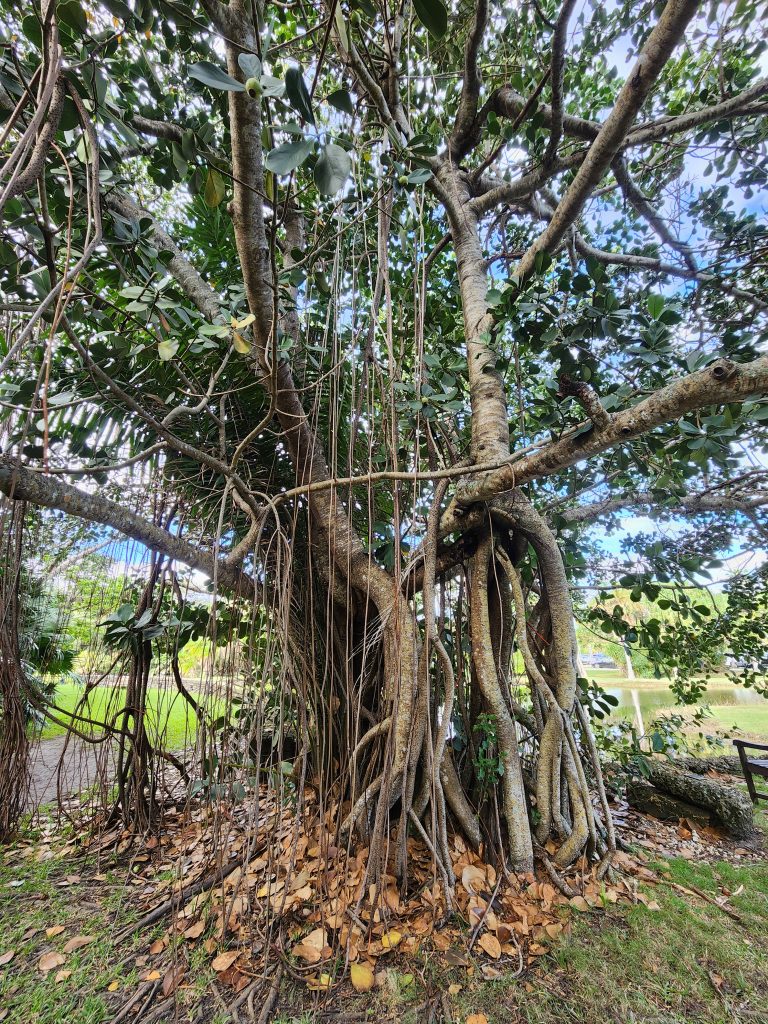Introducing “Flora-da Friendly Features,” a blog series delving into captivating tales of both native and Florida-Friendly plants. Our aim? To spotlight endangered natives, interesting edible and ethnobotanicals, underutilized landscape flora, and plant stories people should hear about. Have a plant in mind that deserves the spotlight? We want to hear from you. Reach out and let us know at fhecker@scgov.net. We want this blog series to be for the plant people by the plant people.
Imposter Pitch Apple?
Rare Native Clusia rosea vs. the Common Clusia guttifera
Have you ever found yourself pondering the mystery of why your pitch apple plant has steadfastly refused to yield even a single fruit? Ah, the enigma unravels in the tangled tendrils of misidentification! It’s quite probable that your beloved pitch apple was, in fact, mislabeled at the time of purchase. Nestled within South Florida’s landscapes, a botanical impostor has stealthily infiltrated gardens and landscapes alike. In this blog, we’ll explore the differences between the native and nonnative Clusia species and shed light on the importance of choosing native plants for a thriving and sustainable landscape. One important aspect for both of species is they need mindful branch pruning; hedge trimmer use on their leaves will quickly make them look awful. I commonly see people putting Clusia in the wrong place in their landscape, leading to high maintenance and poor aesthetics. This is the reason why researching the Right Plant for the Right Place is the #1 principle of Florida-Friendly Landscaping™.

Clusia rosea: The Wildlife Wonder
Clusia rosea stands out with several distinct characteristics that make it a valuable addition to our landscapes. This small tree—related to the magnolia—is commonly called the Florida “Autograph Tree,” due to its leaves resembling parchment ready for signatures. People commonly scratch their names on the leaves in botanical gardens and public parks. It also comes with mangrove-like prop roots and ficus-like aerial roots that can add an element of tropical charm to any setting. These root adaptation lets it grow epiphytically, like a strangler fig in its native range of extreme-southern Florida. This tropical nature also means it is solidly a “Zone 10” plant and will defoliate below 30 degrees Fahrenheit.
Another standout features of C. rosea is its large, magnolia-like flowers that commonly cover the tree. These blooms not only enhance the aesthetic appeal but also play a crucial role in supporting local wildlife, both as flowers and as they turn into the fruit/nut where the plant gets its namesake. The “pitch apples” produced by C. rosea have a historical significance: they were used to seal cracks in wooden boats, giving rise to the commonly accepted name. These fruiting bodies are more similar to hickory nuts than any soft fruit. Meaning they don’t smell, get mushy or attract flies, from my experience. The seeds and blooms actually look and act similar to our Southern magnolia, which is a related tree.

Clusia guttifera: A Dilemma
In contrast, C. guttifera, often mistakenly sold as C. rosea, lacks the distinctive features that make its native counterpart so special. I do want to highlight nurseries are starting to correctly label it, but this new “guttifera” name isn’t in any plant taxonomic databases. Meaning it maightbe a hybrid or just poorly studied by science. The most notable feature of the smaller-leaved C. guttifera is it doesn’t flower or fruit as abundantly as C. rosea. I have personally never seen it bloom or fruit. While this inability to reproduce helps make the plant a Florida-Friendly Landscaping™-approved plant, it also vastly diminishes its role in supporting local wildlife. It does, however, have better cold hardiness compared to the native, withstanding plantings well into “Zone 9,” from my experience while traveling our state.
Overplanting in Landscapes?
The popularity of C. guttifera as a hedge plant raises concerns about potential disease pressures. History has shown that past hedge favorites, like ficus and areca palms, faced challenges due to overplanting, leading to increased vulnerability to diseases. As C. guttifera gains popularity, the risk of similar issues looms on the horizon. Remember, monocultures are not natural and biodiversity is the key to healthy landscapes.
Conclusion
As South Florida continues to develop, the choice of landscaping elements becomes pivotal. C. rosea, with its native charm and wildlife-supporting features, can be a valuable addition to coastal areas in the region. By prioritizing biodiversity and native plants, we can create landscapes that thrive, supporting both the environment and the community. Let’s celebrate the unique beauty of C. rosea and make informed choices when we are purchasing a Clusia species. If you want the native version, you should be going to a nursery that specializes in natives.
Resources
- UF/IFAS EDIS document on C. rosea: https://edis.ifas.ufl.edu/publication/ST172
- Florida Native Plant Society, on C. rosea: https://www.fnps.org/plant/clusia-rosea
- UF/IFAS factsheet highlighting the two species: https://sfyl.ifas.ufl.edu/media/sfylifasufledu/miami-dade/documents/landscapes-amp-gardening/Shrubs-for-your-miami-dade-hedge.pdf
- Univ. of South Florida Plant Atlas: native or nonnative resources: https://florida.plantatlas.usf.edu/Plant.aspx?id=2180
During the preparation of this work, the author used ChatGPT to help build the blog post. After using this tool/service, the author reviewed and edited the content, and takes full responsibility for the content of the publication.
 6
6
